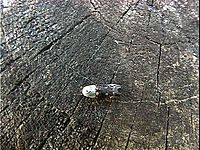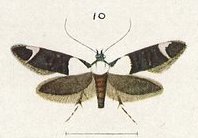Trachypepla euryleucota facts for kids
Quick facts for kids Trachypepla euryleucota |
|
|---|---|
 |
|
 |
|
| Scientific classification | |
| Kingdom: | |
| Phylum: | |
| Class: | |
| Order: | |
| Family: |
Oecophoridae
|
| Genus: |
Trachypepla
|
| Species: |
T. euryleucota
|
| Binomial name | |
| Trachypepla euryleucota Meyrick, 1883
|
|
The Trachypepla euryleucota is a type of moth that belongs to the Oecophoridae family. This moth is special because it is endemic to New Zealand. This means you can only find it living naturally in New Zealand and nowhere else in the world!
Contents
Discovering the Trachypepla euryleucota Moth
This unique moth was first officially described in 1883 by a scientist named Edward Meyrick. He studied moths collected from different places in New Zealand, including Auckland, Wellington, and Dunedin.
Meyrick later shared more details about the moth in a scientific paper in 1884. Another famous insect expert, George Hudson, also wrote about and drew this moth in his 1928 book, The Butterflies and Moths of New Zealand.
Where Was the Moth First Found?
The very first place this moth was identified and studied is called its "type locality." For Trachypepla euryleucota, this was the Botanic Garden and a nearby forest in Wellington.
The original specimen, which is like the official example of the species, is kept safe at the Natural History Museum, London. This special specimen is called a "lectotype."
What Does the Trachypepla euryleucota Moth Look Like?
Edward Meyrick described this moth in detail. Here's a simpler way to imagine it:
- It's a small moth, about 14 to 17 millimeters long. That's roughly the length of a small paperclip!
- Its head, mouthparts (palpi), and antennae are a dark, dusky color.
- The part of its body behind its head (thorax) is white, but the front edge is dark.
- Its belly (abdomen) is also dusky.
- Its legs are dark, with the tips of its feet (tarsal joints) being a bit lighter.
- The front wings are long and dark, with a rounded tip.
- There's a large white patch at the base of the front wings. This patch might have a slight yellowish tint.
- You can see some small, raised spots on the wings that are brownish-orange and have dark edges.
- Near the tip of the front wing, there's a small, white, triangle-shaped spot. From this spot, a thin white line stretches out towards the back edge of the wing.
- The fringes of hair along the edges of the wings are dusky gray.
- The hindwings are also dusky gray, getting darker towards the tip.
Where Do These Moths Live?
You can find Trachypepla euryleucota moths all over New Zealand. They are not limited to just one area.
Life and Habits of the Moth
When Do Adult Moths Fly?
Adult Trachypepla euryleucota moths are usually seen flying around in December and January. They have often been found when the manuka plant is blooming.
Scientists think that when these moths rest, their white head, thorax, and the white part of their wings help them blend in. They might look like an opening manuka flower bud, which helps them hide from predators!
What Do the Larvae Eat?
The young moths, called larvae, have been found eating debris from bird nests. This means they might help clean up by feeding on bits and pieces left behind in nests.


